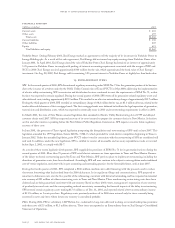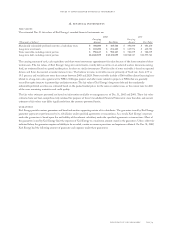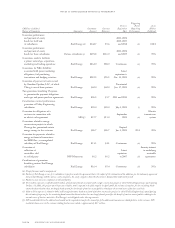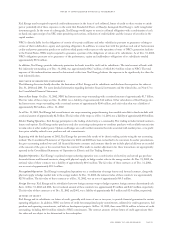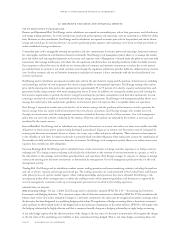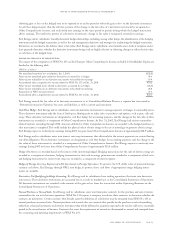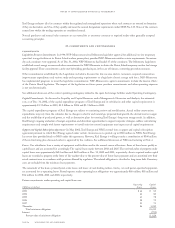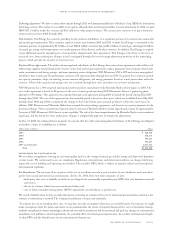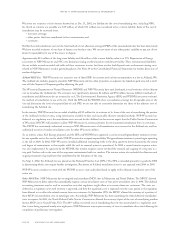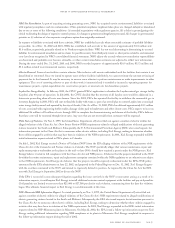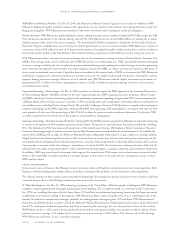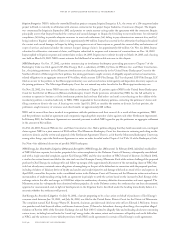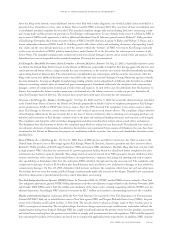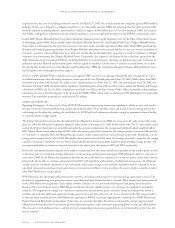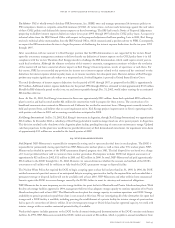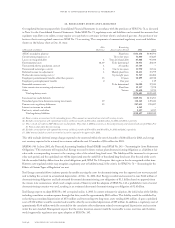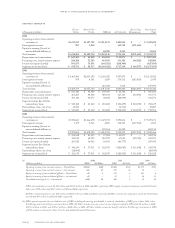Xcel Energy 2002 Annual Report Download - page 74
Download and view the complete annual report
Please find page 74 of the 2002 Xcel Energy annual report below. You can navigate through the pages in the report by either clicking on the pages listed below, or by using the keyword search tool below to find specific information within the annual report.NSP-Minnesota Notice of Violation On Dec. 10, 2001, the Minnesota Pollution Control Agency issued a notice of violation to NSP-
Minnesota alleging air quality violations related to the replacement of a coal conveyor and violations of an opacity limitation at the A.S.
King generating plant. NSP-Minnesota has responded to the notice of violation and is working to resolve the allegations.
Nuclear Insurance NSP-Minnesota’s public liability for claims resulting from any nuclear incident is limited to $9.4 billion under the 1988
Price-Anderson amendment to the Atomic Energy Act of 1954. NSP-Minnesota has secured $200 million of coverage for its public
liability exposure with a pool of insurance companies. The remaining $9.2 billion of exposure is funded by the Secondary Financial
Protection Program, available from assessments by the federal government in case of a nuclear accident. NSP-Minnesota is subject to
assessments of up to $88 million for each of its three licensed reactors to be applied for public liability arising from a nuclear incident at
any licensed nuclear facility in the United States. The maximum funding requirement is $10 million per reactor during any one year.
NSP-Minnesota purchases insurance for property damage and site decontamination cleanup costs from Nuclear Electric Insurance Ltd.
(NEIL). The coverage limits are $1.5 billion for each of NSP-Minnesota’s two nuclear plant sites. NEIL also provides business interruption
insurance coverage, including the cost of replacement power obtained during certain prolonged accidental outages of nuclear generating
units. Premiums are expensed over the policy term. All companies insured with NEIL are subject to retroactive premium adjustments if
losses exceed accumulated reserve funds. Capital has been accumulated in the reserve funds of NEIL to the extent that NSP-Minnesota
would have no exposure for retroactive premium assessments in the case of a single incident under the business interruption and the
property damage insurance coverage. However, in each calendar year, NSP-Minnesota could be subject to maximum assessments of
approximately $7.5 million for business interruption insurance and $21.6 million for property damage insurance if losses exceed
accumulated reserve funds.
Louisiana Generating – Pointe Coupee On Dec. 2, 2002, a petition was filed to appeal the EPA’s approval of the Louisiana Department
of Environmental Quality’s (LDEQ) revisions to the state implementation plan (SIP) regarding emissions regulations. Pointe Coupee
and NRG’s subsidiary, Louisiana Generating, object to the permitting requirements regarding nitrogen oxide (NOx) sources requiring the
LDEQ to obtain offsets of major increases in emissions of NOx associated with major modifications of existing facilities or construction of
new facilities areas, including Pointe Coupee Parish. The plaintiffs’ challenge is based on LDEQ’s failure to comply with requirements
related to rulemaking and the EPA’s regulations, which prohibit EPA from approving a SIP not prepared in accordance with state law. The
court granted a 60-day stay of this proceeding on Feb. 25, 2003, to allow the parties to conduct settlement discussions. At this time, NRG
is unable to predict the eventual outcome of this matter or any potential loss contingencies.
Louisiana Generating – New Construction Air Permits During 2000, the LDEQ issued an air permit modification to Louisiana Generating
to construct and operate two 240-megawatt, natural gas-fired turbines. The permit set emissions limits for certain air pollutants,including
NOx.The limitation for NOxwas based on the guarantees of the manufacturer, Siemens Westinghouse Power Corporation (Siemens).
Louisiana Generating sought an interim emissions limit to allow Siemens time to install additional control equipment. To establish the
interim limit, LDEQ issued an order and Notice of Potential Penalty in September 2002, which is, in part, subject to a hearing. LDEQ
alleged that Louisiana Generating did not meet its NOxemissions limit on certain days, did not conduct all opacity monitoring and did
not complete all record keeping and certification requirements. Louisiana Generating intends to vigorously defend certain claims and any
future penalty assessment, while also seeking an amendment of its limit for NOx.An initial status conference has been held with the
administrative law judge, and quarterly reports will be submitted to describe progress, including settlement and amendment of the limit.
In addition, NRG may assert breach of warranty claims against the manufacturer. With respect to the administrative action described
above, at this time NRG is unable to predict the eventual outcome of this matter or the potential loss contingencies, if any, to which
NRG may be subject.
legal contingencies
In the normal course of business, Xcel Energy is a party to routine claims and litigation arising from prior and current operations. Xcel
Energy is actively defending these matters and has recorded an estimate of the probable cost of settlement or other disposition.
The ultimate outcome of these matters cannot presently be determined. Accordingly, the ultimate resolution of these matters could have
a material adverse effect on Xcel Energy’s financial position and results of operations.
St. Cloud Gas Explosion On Dec. 11, 1998, a natural gas explosion in St. Cloud, Minn., killed four people, including two NSP-Minnesota
employees, injured approximately 14 people and damaged several buildings. The accident occurred as a crew from Cable Constructors
Inc. (CCI) was installing fiber-optic cable for Seren. Seren, CCI and Sirti, an architecture/engineering firm retained by Seren, are named
as defendants in 24 lawsuits relating to the explosion. NSP-Minnesota, Seren’s parent company at the time, is a defendant in 21 of the
lawsuits. In addition to compensatory damages, plaintiffs are seeking punitive damages against CCI and Seren. NSP-Minnesota and
Seren deny any liability for this accident. On July 11, 2000, the National Transportation Safety Board issued a report, which determined
that CCI’s inadequate installation procedures and delay in reporting the natural gas hit were the proximate causes of the accident.
NSP-Minnesota has a self-insured retention deductible of $2 million with general liability coverage limits of $185 million. Seren’s
primary insurance coverage is $1 million and its secondary insurance coverage is $185 million. The ultimate cost to Xcel Energy,
NSP-Minnesota and Seren, if any, is presently unknown.
page 88 xcel energy inc. and subsidiaries
notes to consolidated financial statements


